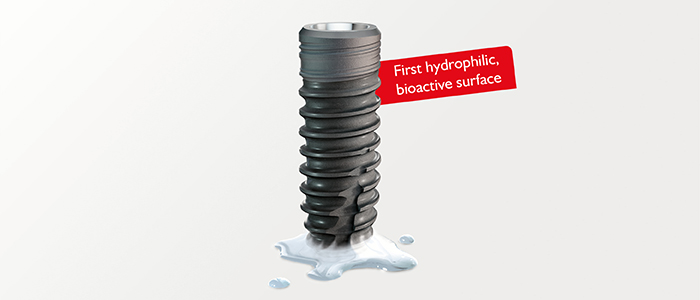BIO-surface

- Speeded-up formation of a functional bone-implant contact
- Reduction of treatment time
- Immediate loading

The unique alkali-treated bioactive surface of the implant accelerates the process of bone-implant contact formation, providing the implant with increasing secondary stability at the earliest stages of healing. This phenomenon helps to reduce the healing time and enables early and immediate loading to become a predictable and safe treatment protocol.
- Bioactive
- Hydrophilic
- Nano-structured surface of implants
Hydrophilic BIO-surface
As a result of long-term, continuous research into biomaterial-body environment interactions, LASAK was the first company on the European market that was able to offer an unique nano-structured, hydrophilic and bioactive surface treatment – the BIO-surface . The experimental and, especially, the widely documented clinical results confirmed that dental implants with the BIO-surface speed up the formation of a functional bone-implant interface, thus improving the implant’s secondary stability in the early healing phase. Thanks to the BIO-surface, the stability dip – often observed in nonbioactive surfaces – is eliminated. The outstanding performance of BIO-surface implants has been documented for even the most demanding indications. This bioactive surface is used in more than twenty countries in the world, e. g. in Germany, Sweden; a really good representation of Czech science abroad.
What makes BIO-surface unique?

Bioactivity has been defined as the characteristics of an implant material that allows it to form a bond with living tissues. It was first detected in the late nineteen sixties: in a group of materials called bioactive glasses, which bonded to bone within days. Machined-smooth titanium can be regarded as a bio-inert material that becomes encapsulated by soft tissue and forms a direct contact with bone (osseointegration) only under certain conditions and after long time periods. Since the discovery of osseointegration, the history of dental implantology has been closely linked with efforts to modify the surface of titanium (e.g. by roughening) in order to bring the surface reactivity of titanium closer to bioactive materials and thus enable titanium to form a stable and functional interface with bone in the shortest time. LASAK has developed a three-step surface treatment that combines mechanical- and chemical-treatment methods to achieve a unique, three-dimensional, macro-, micro- and nano-structured bioactive titanium surface – the BIO-surface . The BIO-surface stimulates cell attachment, differentiation and bone matrix synthesis leading to an increased bone-implant contact in a shorter time.

The surface treatment used in the preparation of the BIO-surface increases the density of hydroxyl groups on the surface as compared to other measured surfaces. The level of hydration of the BIO-surface was higher by roughly an order of magnitude compared to that of other surfaces. The chemical modification of the BIO-surface at the nano-scale makes the surface hydrophilic (low contact angle) and enables an active ion interaction with the blood plasma long before the bone-forming cells can attach. Its excellent wetting properties enable the fast penetration of blood into the complex structure of the BIO-surface.

